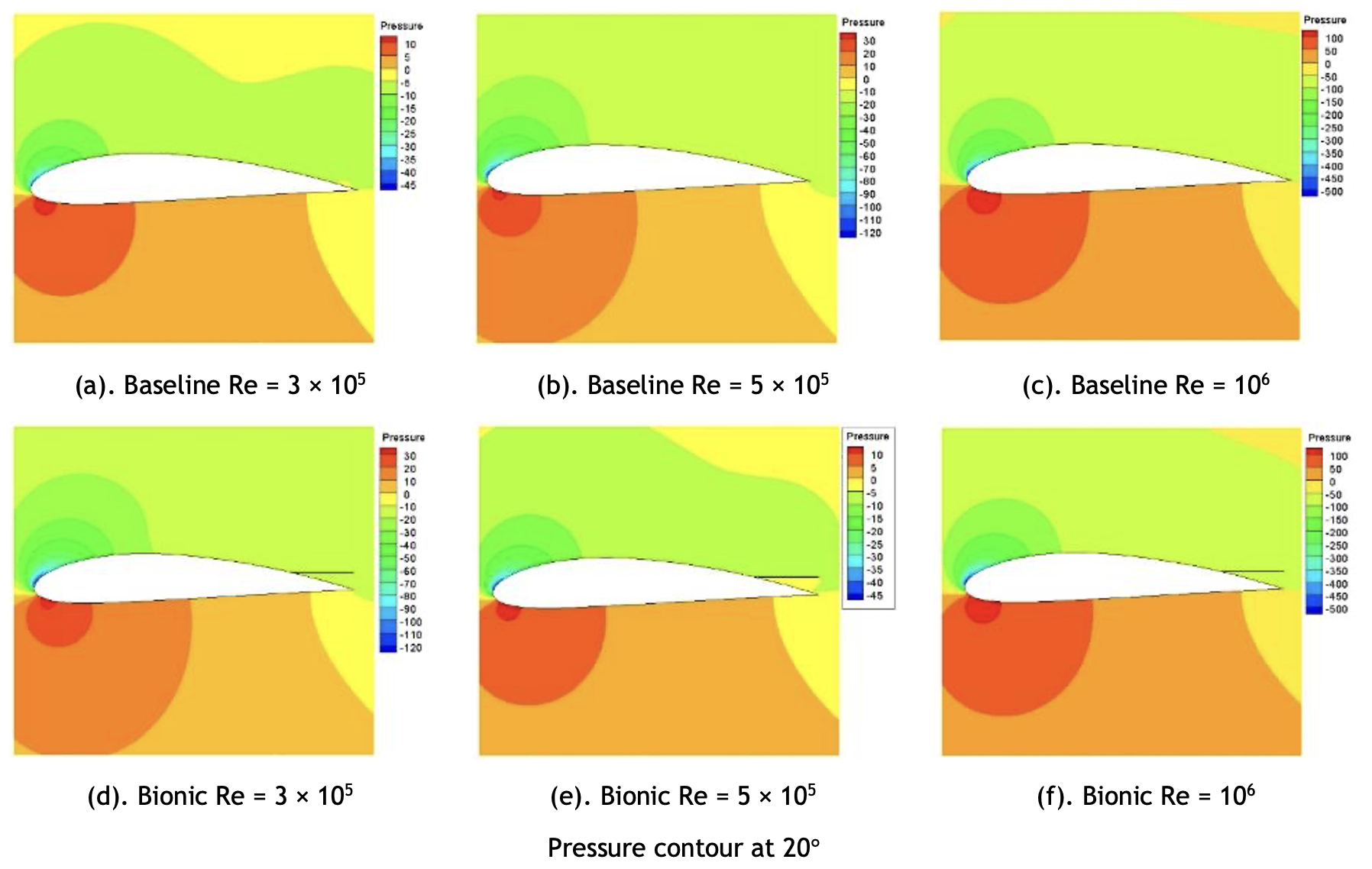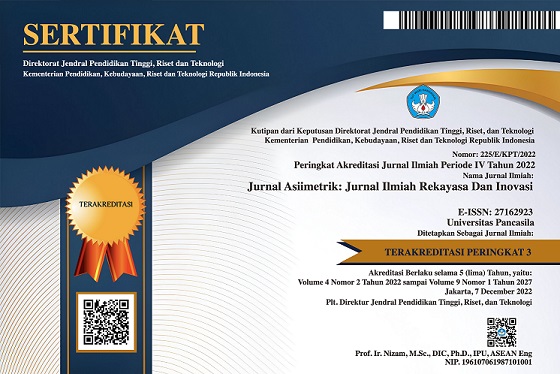Analysis of the Use of Bio Flap on NACA 4415 with Numerical Methods
Analisis Penggunaan Bio Flap pada NACA 4415 dengan Metode Numerik
DOI:
https://doi.org/10.35814/asiimetrik.v5i2.4768Keywords:
aerodynamics, airfoil, bionic flaps, NACA 4415, Reynolds numberAbstract
This study was conducted using the Computational Fluid Dynamics (CFD) method using the Reynolds Averaged Navier Stokes (RANS) approach. The type of airfoil used in this study is the asymmetry NACA 4415 airfoil type. In this paper, computational tests were carried out on the airfoil with the addition of bionic flaps on its trailing edge. This study's update tests three variations of the Reynolds number: Re = 106, Re = 5 × 105, and Re = 3 × 105. The airfoil test was carried out at AoA 0°–25°. The addition of bionic flaps causes a decrease in lift performance at low AoA, but at high AoA, it can increase lift performance on airfoils. In addition, adding a bionic flap on the airfoil can delay the occurrence of a stall. At AoA 10°–13°, the Cd of the three variations of the Reynolds number experiences an increase in performance. Then, from this computational test, the resulting Coefficient moment (Cm) is a pitch down because the torque is below zero.
Downloads
References
Aftab, S.M.A. et al. (2016) ‘Turbulence Model Selection for Low Reynolds Number Flows’, PLOS ONE, 11(4), pp. e0153755–e0153770.
Alom, N., Borah, B. and Saha, U.K. (2018) ‘An insight into the drag and lift characteristics of modified Bach and Benesh profiles of Savonius rotor’, Energy Procedia, 144, pp. 50–56.
Altman, A. and Allemand, G. (2016) ‘Post-Stall Performance Improvement through Bio-inspired Passive Covert Feathers’, in 54th AIAA Aerospace Sciences Meeting. American Institute of Aeronautics and Astronautics.
Bardera-Mora, R. et al. (2019) ‘Aerodynamic Flow Effects on Aircraft Carrier Takeoff Performance’, Journal of Aircraft, 56(3), pp. 1005–1013.
Hao, L. et al. (2021) ‘Numerical Simulation of Flow over Bionic Airfoil’, International Journal of Aerospace Engineering, 2021, p. e5556463.
He, X. et al. (2019) ‘Robust aerodynamic shape optimization—From a circle to an airfoil’, Aerospace Science and Technology, 87, pp. 48–61.
Hoffmann, M.J., Reuss Ramsay, R. and Gregorek, G.M. (1996) Effects of grit roughness and pitch oscillations on the NACA 4415 airfoil. NREL/TP-442-7815. National Renewable Energy Lab. (NREL), Golden, CO (United States); The Ohio State Univ., Columbus, OH (United States).
Iskandar, W. and Julian, J. (2022) ‘Study of Airfoil Characteristics on NACA 4415 with Reynolds Number Variations’, International Review On Modelling And Simulations (IREMOS), 15(3), pp. 162–171.
James, S.E. et al. (2018) ‘Comparative study of boundary layer control around an ordinary airfoil and a high lift airfoil with secondary blowing’, Computers & Fluids, 164, pp. 50–63.
Julian, J. et al. (2016) ‘The Effect of Plasma Actuator Placement on Drag Coefficient Reduction of Ahmed Body as an Aerodynamic Model’, International Journal of Technology, 7(2), pp. 306-313.
Julian, J. et al. (2022) ‘Effect of Single Slat and Double Slat on Aerodynamic Performance of NACA 4415’, International Journal of Marine Engineering Innovation and Research, 7(2), pp. 93–100.
Julian, J. et al. (2023) ‘Aerodynamic Performance Improvement on NACA 4415 Airfoil by Using Cavity’, Jurnal Asiimetrik: Jurnal Ilmiah Rekayasa Dan Inovasi, 5(1), pp. 135–142.
Karim, R.F. and Julian, J. (2018) ‘Drag reduction due to recirculating bubble control using plasma actuator on a squareback model’, in ICET4SD 2017. The 2nd International Conference on Engineering and Technology for Sustainable Development, Indonesia: MATEC Web of Conferences, p. 01108.
Kumar, P. and German, B.J. (2022) ‘Optimization of High-Lift Systems at Takeoff Conditions Subject to Kinematic Constraints’, Journal of Aircraft, 59(4), pp. 1098–1103.
Lang, X. et al. (2021) ‘Aerodynamic performance of owl-like airfoil undergoing bio-inspired flapping kinematics’, Chinese Journal of Aeronautics, 34(5), pp. 239–252.
Lew†, A.J., Buscaglia, G.C. and Carrica, P.M. (2001) ‘A Note on the Numerical Treatment of the k-epsilon Turbulence Model*’, International Journal of Computational Fluid Dynamics, 14(3), pp. 201–209.
Li, J., Bouhlel, M.A. and Martins, J.R.R.A. (2019) ‘Data-Based Approach for Fast Airfoil Analysis and Optimization’, AIAA Journal, 57(2), pp. 581–596.
Müller, L. et al. (2014) ‘Aerodynamic Installation Effects of an Over-the-Wing Propeller on a High-Lift Configuration’, Journal of Aircraft, 51(1), pp. 249–258.
Nair, N.J. and Goza, A. (2020) Numerical study of a passively deployable flap for aerodynamic flow control, p. X02.016.
Nair, N.J. and Goza, A. (2022) ‘Fluid-structure interaction of a bio-inspired passively deployable flap for lift enhancement’, Physical Review Fluids, 7(6), p. 064701.
Radespiel, R. and Heinze, W. (2014) ‘SFB 880: fundamentals of high lift for future commercial aircraft’, CEAS Aeronautical Journal, 5(3), pp. 239–251.
Raymer, D. (2018) Aircraft Design: A Conceptual Approach, Sixth Edition. 6th edn. American Institute of Aeronautics and Astronautics [Print].
Roache, P.J. (1994) ‘Perspective: A Method for Uniform Reporting of Grid Refinement Studies’, Journal of Fluids Engineering, 116(3), pp. 405–413.
Rubel, R.I. et al. (2016) ‘Comparison of Aerodynamics Characteristics of NACA 0015 & NACA 4415’. Switzerland: Preprints MDPI.
Supriya, D. et al. (2019) ‘Accurate higher order automated unstructured triangular meshes for airfoil designs in aerospace applications using parabolic arcs’, Aerospace Science and Technology, 88, pp. 405–420.
Wu, L. et al. (2022) ‘Using the combined flow control accessory to the aerodynamic performance enhancement of bio-inspired seagull airfoils’, Journal of Renewable and Sustainable Energy, 14(2), p. 023302.
Xiao, H. et al. (2016) ‘Quantifying and Reducing Model-Form Uncertainties in Reynolds-Averaged Navier-Stokes Simulations: A Data-Driven, Physics-Based Bayesian Approach’, Journal of Computational Physics, 324, pp. 115–136.
Xie, Y.H. et al. (2016) ‘Numerical investigation into energy extraction of flapping airfoil with Gurney flaps’, Energy, 109, pp. 694–702.
Zhang, W. et al. (2015) ‘Geometrical effects on the airfoil flow separation and transition’, Computers & Fluids, 116, pp. 60–73.
Zhang, W. et al. (2017) ‘Main characteristics of suction control of flow separation of an airfoil at low Reynolds numbers’, European Journal of Mechanics - B/Fluids, 65, pp. 88–97.
Zhao, D.J. et al. (2015) ‘Optimization of Suction Control on an Airfoil Using Multi-island Genetic Algorithm’, Procedia Engineering, 99, pp. 696–702.
Zhao, Y. and Sushama, L. (2020) ‘Aircraft Takeoff Performance in a Changing Climate for Canadian Airports’, Atmosphere, 11(481), pp. 1–22.





























